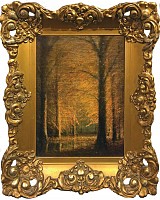BIOGRAPHY

Harvey Joiner (American 1852-1932)
Like his contemporary Alexander Drysdale of New Orleans, Kentucky artist Harvey Joiner created an extraordinary body of work based upon a simple compositional format which he repeated, with only slight variation, in hundreds of paintings. This reiterated format became a formula for suggesting two conceptual constructs simultaneously: first, the great sense of depth and perspective experienced when standing at the edge of a forest and looking down a line of adjacent trees seemingly placed in random order, and secondly, the subliminal suggestion of transcendental elevation that viewing experience conveys to the viewer’s consciousness.
To achieve this, Joiner placed rows of towering beech trees—leaning towards each other across a narrow gap in the forest—in a consistent pattern, diminishing the size of the tree from foreground to rear ground as a means of enhancing the illusion of space and depth. To elevate the viewing experience to a transcendental level, he deployed a lateral light to pierce the space between the trees, imbuing them with a sense of motion. During his lifetime, this formulaic practice earned Joiner steady financial reward and local popularity.
Born in Charlestown, Indiana, northeast of Louisville, Kentucky, Charles Harvey Joiner displayed a childhood affinity for art. Accounts of his early training are contradictory, but by 1874, he was working in St. Louis, where he made the acquaintance of a German portrait painter, David Hoffman, from whom he learned the basics of portraiture and copying from photographs. His most impressive extant accomplishments in the area of portraiture are the grand manner pendant portraits of Russell M. Hughes, a successful vinegar manufacturer, and his wife. Joiner also recorded the likeness of Louisville songwriter William Shakespeare Hays.
Joiner began to participate in the Louisville art scene in 1875, using it as a base from which to work as an itinerant portraitist and occasional painter of church interiors. In this latter pursuit, especially popular in the German and Italian Roman Catholic communities, he painted in southern Illinois and Utica, Indiana, where his Ruth Gleaning in the Fields of Boaz remains intact at the local Church of Christ. After his marriage in 1878, Joiner established a permanent home in the area, as well as a portrait studio in the Louisville Courier-Journal building.
Apart from a brief sojourn in Pittsburgh in the early 1880s and some abbreviated travel in the American West, Joiner worked from this location for the rest of his career, attracting patrons from across the country. In a late-career tribute to Joiner’s accomplishments, the Louisville Times reported in 1929 that he was thought to have created over five thousand works. Today, his works can be found in the permanent collections of several Kentucky institutions, as well as the Indiana State Museum and the Morris Museum of Art. The Johnson Collection, Spartanburg, South Carolina.
